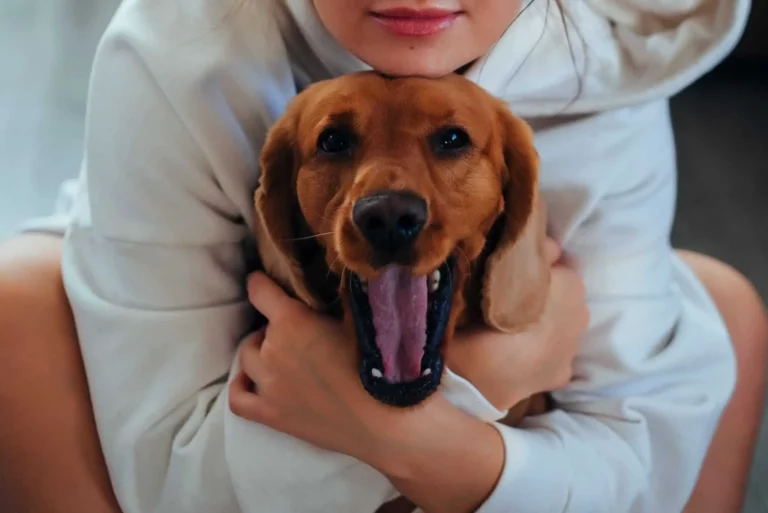Why Do Dogs Put Their Head Down and Bum Up in the Air (7 Reasons Revealed)
No doubt, our four-legged companions are smart and sophisticated creatures. They never cease to intrigue us with their different means of communication.
Hence, it’s important that we familiarize ourselves with various verbal and non-verbal cues, both of which are integral in understanding our dog’s mood and intentions.
The bum-up-and-head-down pose is a universal body language in the canine world and it has inspired the popular downward dog yoga pose.
Most seasoned dog owners view this fascinating pose as a source of comic relief, but newcomers may find it bizarre but it is definitely one that piques your curiosity and makes you want to ask “why?”
Most times dogs stick their bum in the air with their head down, they are just engaging in the activity termed “play bow” — which signals a fun invitation to play, but this pose could also be done as a physically stimulating stretch, a mating call, or just something your dog enjoys doing.
If your dog is feeling uneasy in this position, it’s highly possible that your dog is experiencing abdominal pain. In this case, it would be wise to visit your veterinarian.
It’s not always all shades of bad with this situation but it’s crucial to take a closer look before drawing a conclusion.
For example, when your pooch keeps his bum up almost all the time, this may be a sign of underlying health problems but on the other hand, a graceful stretch coupled with a wide yawn might just mean another happy day for your pooch.
We’ll delve deeper into the various reasons why dogs stick their bum up with their head down and answer some related questions so that you can better understand your dog through their body language.
Key takeaways
The “play bow” posture signifies a desire to play.
It’s a universal dog language and is not breed-specific.
Some dogs may overuse this gesture due to a high energy level.
It’s not a sign of aggression or illness.
Encouraging play helps bond with your pet.
Why Do Dogs Put Their Head Down and Bum Up in the Air?
1. Friendly Play Invitation Or Socialization
One of the most common reasons why dogs place their bum up and head down is to give signals to other dogs, their humans, or other pets that they are ready to play. The word used to describe this is “play bow”.
In this position, your dog extends his forelimbs with his elbow reaching the ground while his chest and head are raised a few millimeters above the ground. You may also notice tail wagging or a relaxed and happy facial expression.
This is seen more frequently with very lively and energetic breeds. It’s just one of many calming signals dogs use to de-escalate confrontations. Even humans can replicate this pose to come across as friendly to their pooch.
When introducing one canine to another, take a close look at their body language and keep an eye out for the “bow”, or other calming signals like yawning, licking, sitting down, slightly lifting one paw, or smiling. It’s generally a good sign for both dogs as they are now able to socialize without perceiving each other as a threat. It’s more like the dog’s “icebreaker” gesture.
2. Might Be Stretching
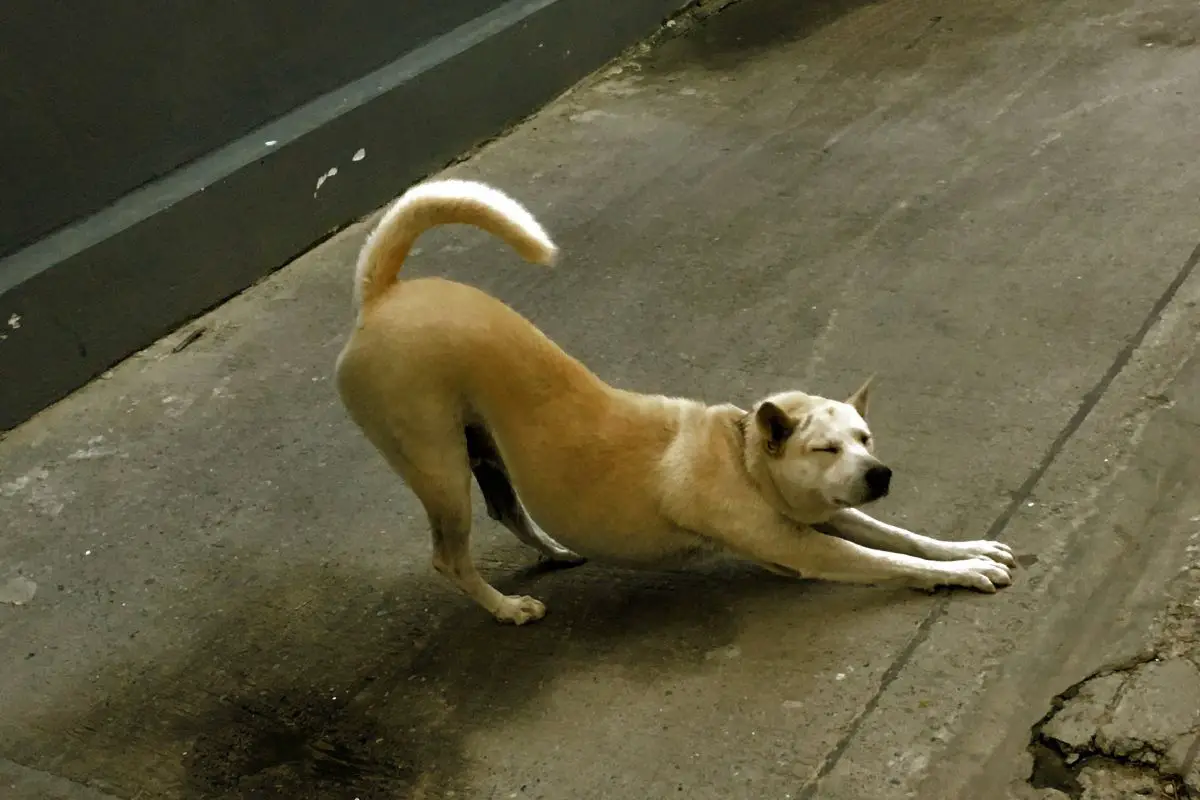
Whether it’s after waking up from sleep in the morning or having a short nap session at noon, dogs stretch just like humans and this activity provides several benefits to your dog’s health.
First, stretching is a common behavior in canids — animals that include wolves, coyotes, foxes, jackals, dingoes, and other species in addition to domestic dogs. As athletic hunters, canids usually stretch to get themselves ready for physical activities like hunting or defensive combat to secure their territory. By doing so, they get to warm up their muscles and improve their balance and blood circulation.
You can also include stretches as part of your dog’s daily exercise. You’ll have to allow your dog to perform this movement naturally, then mark it with a marker word, followed by a reward. Do this consistently and include verbal cues so you can easily signal your dog when you need him to stretch.
While stretching is just a physical activity, it can also be of benefit to your dog’s mental well-being. Furthermore, your dog can also stretch to relieve stress, back pain, arthritis, or even abdominal pain. So, that leads us to the next reason.
3. Possible Health Concerns
Any health condition that causes pain or discomfort of any sort can trigger behavioral changes or physical symptoms in dogs. Dogs find relief from painful situations by yelping, licking, and scratching. Hence, it’s not so surprising why your dog may resort to performing the downward dog pose.
Of course, injury to a bone or joint, as well as surgical wounds, will produce gruesome pain in dogs, but also numerous underlying health conditions will result in pain or discomfort of some sort. Pancreatitis, bloat, intestinal obstruction, arthritis, sprains, and dental problems are among the most prevalent. Usually, dogs with these conditions appear uncomfortable and may stretch out to vent their frustration
If you suspect any of these issues in your dog, it’s important to schedule an appointment with your vet as soon as possible. Also, take note of the all other signs your dog exhibits to help your vet understand the condition better.
If your dog has had any previous health conditions, you can inquire with your vet whether it is associated with any painful symptoms.
4. Submissive Behavior
Dogs often crouch to show submission but there are times bowing might convey similar intentions. Submissive canines often try to lower themselves (crouch) to seem smaller than they are upon meeting another dog.
It signals the other dog that they are not in any form a source of intimidation. It can be accompanied by other submissive behaviors like muzzle licking, avoiding eye contact, and urination.
In the pack hierarchy, the position of each dog is typically determined by interactions among all members of the pack. Hence, dogs at the bottom of the hierarchy are usually more submissive to the top-ranked individuals.
Normally, it’s not a problem if your dog has some submissive traits but you should be worried if your dog is overly submissive and fearful. This is usually a result of under-socialization and can be resolved by taking your dogs to places where they can meet other dogs. If your dog has a history of abuse, you can seek help from an animal behaviorist or qualified dog trainer to assist him in dealing with his fearsome attitude.
5. Wants To Burn Off Pent-Up Energy
Exercise is an integral part of your dog’s daily life and when he’s deprived of it, this can result in hyperactivity and anxiety. Hence, dogs somehow try to burn off excess calories. The fun fact here is that your pooch will always try to communicate this behavior using various body language.
If your dog is trying to lower their head and elevate their butt to the air, there is a possibility that this behavior is caused by a lack of physical activity or he just feels trapped and needs adequate space to roam and play freely.
Dogs that lead a sedentary lifestyle are prone to muscle and joint pain from soreness. In this situation, your dog may take the downward dog stance as a way to relieve this pain.
It’s important to provide your dog with an adequate amount of exercise appropriate to their age, size, breed and health status. Take your dog on daily walks, and engage in other physically stimulating activities.
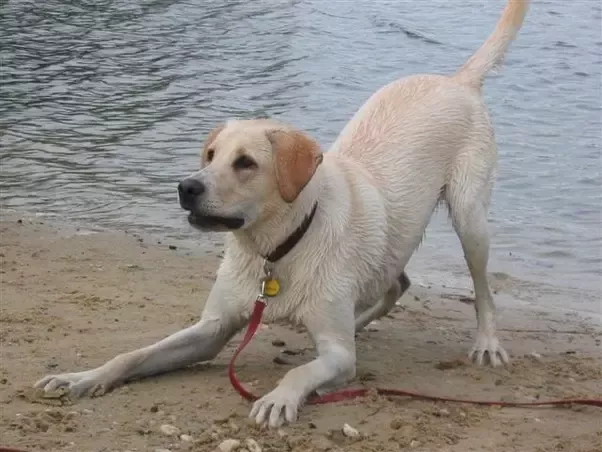
6. Sexual Behavior
Just like humans, dogs flirt with the opposite gender. They often display myriads of sexual poses when around their female counterpart and display high interest in her particularly when she is in heat. The male dog is attracted to the female because he senses the various pheromones she produces during this period.
While the head-down-butt-up gesture may not be a typical premating behavior in canines, it’s definitely one of the ways dogs communicate their sexual attraction to their mates.
Dogs are sexual creatures and sometimes do not need to be around female dogs to display sexual behaviors. Dogs are often found humping stuffed toys, humans, couches, blankets, and pillows. This is due to their high sexual drive and most owners resort to neutering in this case.
7. For Pleasure and Relaxation
Dogs mostly find pleasure in what turns into a regular habit. In essence, some dogs find the downward dog pose interesting and enjoyable. So, they just keep doing it.
Other dogs often perform this behavior as a temporary remedy to their stress and anxiety. It’s just like humans stretching out after long hours of work because of the relief it brings.
Hence, it’s crucial to always make sure your dog is in an easy state. Offer them an appropriate diet, adequate exercise, and regular medical checkups. Your fur baby will be ever grateful.
What is my dog thinking?
This is the classic “play bow” position, a universal signal in the dog world that your pooch is ready for some fun and games.
My Dog Keeps Sticking His Bum In The Air. Should I Stop Him?
The play bow gesture is a part of natural and harmless behavior in dogs. Hardly, is it regarded as a major cause for concern, rather, it’s usually encouraged to improve socialization and playful interactions between dogs. It also helps your dog stretch and gets ready for physically demanding activities.
As a dog owner, it’s still important to understand your dog’s body language to know what’s normal and what’s not. There are times when dogs might just be displaying all sorts of weird behaviors because of the discomfort or pain they are experiencing.
Dogs often lift their bum and lower their head in a stretch, when they have digestive disorders like bloating, abdominal pain, constipation, diarrhea and vomiting. It helps if you can inspect your dog properly for any signs of pain or discomfort like unusual vocalization, restlessness, anxiety, increased rate of breathing and trembling.
If you think your dog is in pain, schedule a vet appointment to find out the cause of the pain.
Also, bear in mind that dogs may stretch because of their physically stimulating benefits. Rather than trying to force your pooch to stop this behavior, you can make sure they get enough exercise on a daily basis. And as well, give them a free space to roam and burn off exercise energy.
Beta dogs often lower themselves when they meet other dogs (fearful crouching). This may signal fear. Issues like this are caused by poor socialization or abusive owners. Sometimes, you can improve your dog’s social skills and confidence by merely socializing with them. Other times, you may need professional help to facilitate the process.
How to Teach Your Dog to Take a Bow – A Step-by-Step Guide
Step 1: Prepare your training environment
Choose a quiet, distraction-free space to start your training sessions. Ensure that your dog is comfortable and familiar with the area. Have treats or your dog’s favorite toy on hand to use as a reward.
Step 2: Get your dog’s attention
Make sure your dog is focused on you before starting the training session. You can use a clicker, a verbal cue like “watch me,” or simply call your dog’s name.
Step 3: Lure your dog into the bow position
Hold a treat in your hand and let your dog sniff it. Slowly lower the treat towards the ground between your dog’s front legs. As your dog’s head follows the treat, their chest should lower towards the ground while their hindquarters remain up in the air.
Step 4: Mark and reward the correct position
As soon as your dog achieves the bow position, use a clicker or a verbal marker like “yes” to mark the behavior. Immediately reward your dog with the treat or toy. Remember to praise them enthusiastically.
Step 5: Add a verbal cue
Once your dog is consistently getting into the bow position, it’s time to add a verbal cue. As you lure your dog into the bow position, say a command like “take a bow” or “bow.” Continue marking and rewarding the correct position.
Step 6: Gradually fade the lure
Begin to reduce the use of the treat or toy as a lure by gradually raising your hand above your dog’s nose while still giving the verbal cue. Eventually, your dog should be able to perform the bow on command without the need for a lure.
Step 7: Add a release cue
Teach your dog a release cue like “okay” or “all done” to signal the end of the bow. This will help your dog understand when they can break the position and resume normal activities.
Step 8: Practice and prove the behavior
Continue practicing the behavior with your dog, gradually increasing the duration of the bow and introducing distractions. Practice in various environments to help your dog generalize the behavior.
Step 9: Be patient and consistent
Teaching your dog to take a bow might take time and patience. Remember to be consistent with your cues and rewards, and always end training sessions on a positive note.
By following these steps, you’ll be able to teach your dog to take a bow, providing a fun and engaging trick that also reinforces positive behaviors and strengthens the bond between you and your furry companion.
Why Does My Dog Lower His Head and Stare at Me?
Depending on your dog’s look and temperament, this could have different meanings. For some dogs, it’s a way of expressing fear and remorse when they feel that they might have displeased their owners (apology bow). Other dogs may just be needy and want you to feel sorry for them or give them a bite of your meal.
Especially in herding dogs like border collies, this action may be a display of dominance. In this case, you must teach them not to herd people. Obedience training is important in eliminating such behavioral problems and making your dog understand who is in charge.
Why Does My Dog Put His Head Down When I Pet Him?
This behavior doesn’t necessarily mean that your dog is trying to be submissive. In fact, the most common reason why dogs lower their head when petted is clearly that they don’t like it or maybe they just don’t like the head touch and would prefer a pat on the back.
Dogs are sensitive creatures and, on some occasions, when your hand is getting closer to them, their reflex is triggered to avoid it just like any object trying to hit them. You can help your dog understand that pats are normal and enjoyable by simply using positive reinforcement.
My Dog Can’t Get Comfortable And Keeps Stretching
A possible reason why dogs become restless and stretch out is when they are feeling pain or discomfort. The most common cause of pain in this situation is gastrointestinal issues. If you’re not sure whether your dog is in pain call your vet to be on the safer side. In serious cases, emergency veterinary care is required to tackle the problem hands-on.
It could also be that your dog is not allowed to roam freely or is deprived of exercise. Consequently, they tend to feel cramped and frustrated and may stretch to vent out excess energy. Stretching is also a way dogs get quick relief in cases of muscle soreness caused by prolonged inactivity. In essence, exercise is crucial for the health of your four-legged friend.
Final Thoughts
The “play bow” is a universal canine body language that signals a desire to engage in friendly, non-threatening play. Understanding this behavior can help pet owners better communicate with their dogs and foster a strong, healthy bond.
When a dog puts their head down and bum up, they are simply inviting you or another dog to join in a fun and interactive play session.
As a pet owner, it is essential to recognize and respond positively to your dog’s play signals, providing them with ample opportunities for socialization and exercise. Regular playtime can contribute to your dog’s overall well-being and happiness, ensuring a balanced and fulfilling life for your beloved furry companion.
So, the next time you see your dog performing the play bow, don’t hesitate to join in the fun and strengthen the bond you share with your best friend.

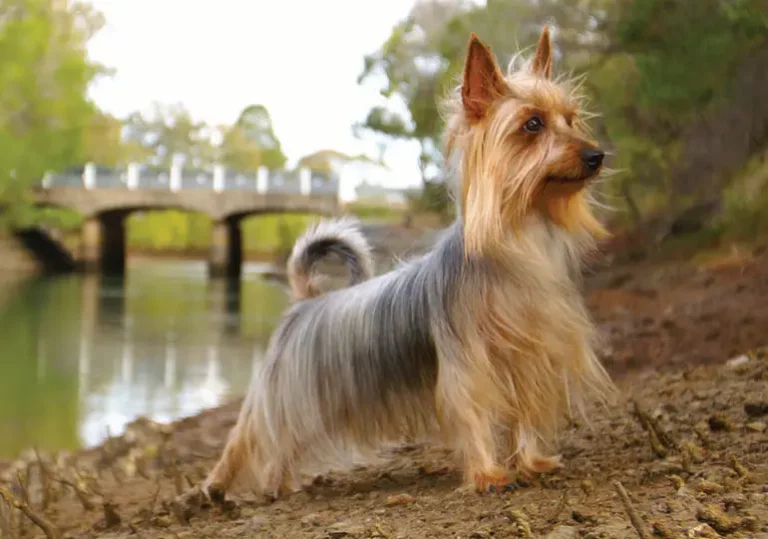
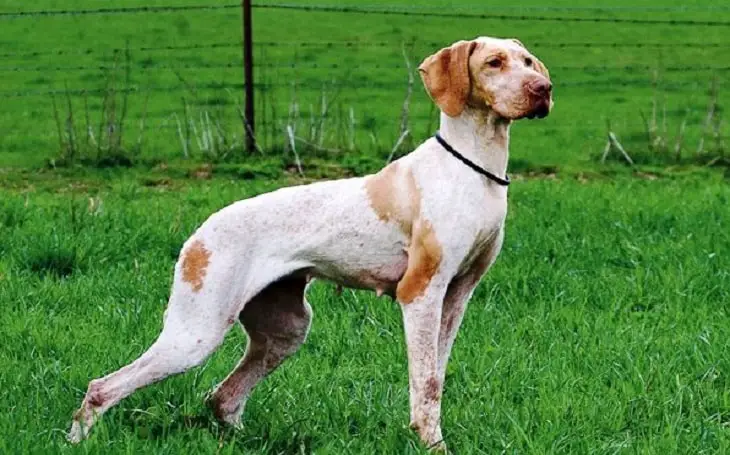

![Can a Dog Eat Pork Rib Bones? [3 Risks You Need to Know]](https://www.warmlypet.com/wp-content/uploads/2022/12/Can-a-Dog-Eat-Pork-Rib-Bones.webp)

